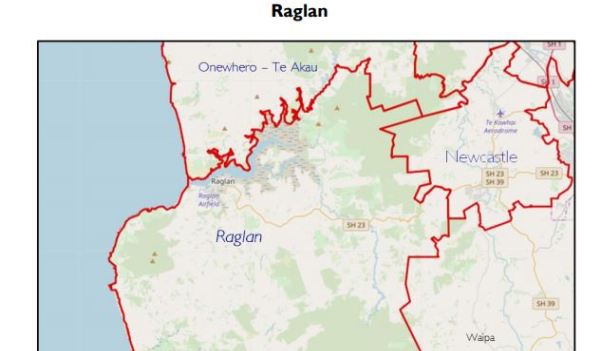 District councillors have rejected submissions to align the Raglan Community Board and Ward boundaries. The summary document about the representation decisions made by the councillors says that 147 submissions were received:
District councillors have rejected submissions to align the Raglan Community Board and Ward boundaries. The summary document about the representation decisions made by the councillors says that 147 submissions were received:
- 19 submissions indicated their support of the Initial Proposal;
- 126 submissions indicated that they did not support the Initial Proposal;
- 2 submissions gave no indication (or it was not clear to determine) if they did or did not support the Initial
Proposal
No analysis was provided of the submissions made by Raglanites and no reasons were given on the reason for rejecting the submissions to align the Raglan Community Board and Ward boundaries. One interesting fact provided is that the population of the Raglan Ward is now 5,790. This means that our sole and very busy councilor, Lisa Thomson is representing 5,790 people.
On the census night in 2013 the population of the Raglan Ward was 4,290. By 30th June 2015 the population had increased to 5,510 and now it has increased to 5,790. This equals a 35% population increase since 2013.
Raglan Community Board will continue to have six members elected from the community at large, plus one
councillor representing the Raglan Ward as appointed by Council, being the existing community board area comprising the area delineated on LGC-013-2013-Com-5 deposited with Land Information New Zealand.
The final proposal is now open for appeals or objections until 5pm 12 October 2018 and a final determination will be made by the Local Government Commission, if required, in April next year.
Waikato District Council media release, 13 September 2018
Council notifies final representation review proposal
The Waikato District Council this week notified its final proposal for representation arrangements for the next local body elections, including the shape of the district’s voting Wards and the number of Councillors elected.
As a result of public submissions received, the Council has decided that it will not proceed with its initial proposal to shift Mercer from Awaroa ki Tuakau Ward into Whangamarino Ward, nor to move Rangiriri from Whangamarino Ward to Hukanui-Waerenga Ward. However, a small part of Awaroa ki Tuakau Ward’s northeastern rural community will still move into Whangamarino Ward and a portion of Whangamarino’ southeastern rural community will move into the Humaui-Waerenga Ward under the final proposal.
Also as a result of submissions received, the Council has decided against disestablishing the Onewhero-Tuakau Community Board and splitting it into two new bodies. Instead the final proposal extends the size of the Community Board to take in areas surrounding Tuakau that were originally intended to be part of a separate Tuakau Community Board under the initial proposal.
Waikato District Mayor Allan Sanson says, “We’re required to review these arrangements at least once every six years to ensure that individuals and communities in our district are fairly represented on and by the Council.
“Our initial proposal was designed to offer fairer representation in our northem-most Awaroa ki Tuakau Ward where the district’s population has grown. However we’ve listened to our people in Mercer, Rangiriri and elsewhere who did not want to see their current representation change before the 2019 elections, so we’ll just keep an eye on our population growth and review things again at an appropriate time.”
The Council’s final proposal continues to recommend retaining 13 councillors elected from 10 wards (plus the Mayor elected at large).
In 2017 the Council made two other important decisions as a part of the representation review process – the decision to retain ‘first-past-the-post’ as the electoral system; and the decision not to introduce Maaori wards in the district, but to explore ways by which Maaori interests can be better-represented through Council processes.
The final proposal is now open for appeals or objections until 5pm 12 October 2018 and a final determination will be made by the Local Government Commission, if required, in April next year.


